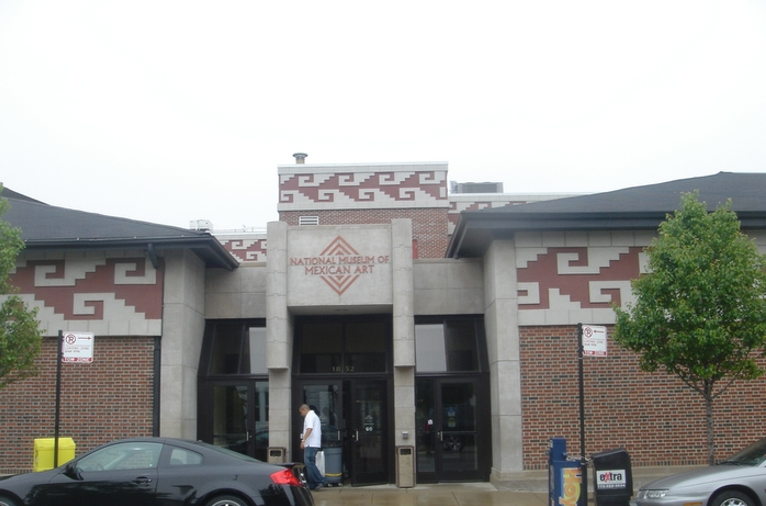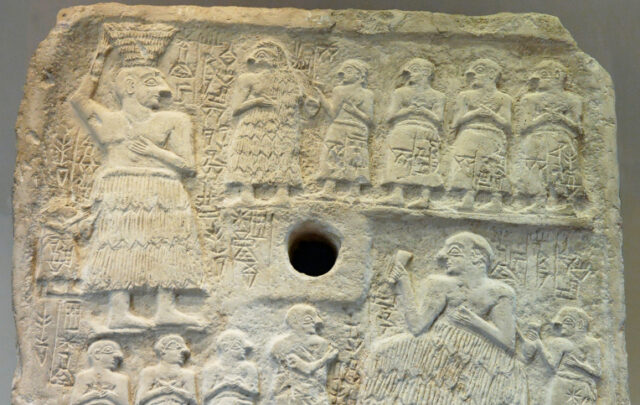Entering the second floor of the two-story brick building in Chicago’s Little Village neighborhood, visitors are greeted by colorful walls adorned with neon LED signs and vibrant artwork. There’s a street art space full of murals, a radio station with professional audio equipment, and a computer lab with photo and video editing software. And everywhere, there are young people collaborating with each other and with mentors. This is Yollocalli Arts Reach, an arts and cultural project of the National Museum of Mexican Art.
“It is this place of cool teens making art,” says Emmanuel Ramirez, age 18, a longtime student of the program. Ramirez stumbled upon Yollocalli while attending an after-school program at the Boys & Girls Club, which is located on the first floor of the same building. At 12, he was not old enough to join any of the Yollocalli programs, so for a year, Ramirez snuck out of the Boys & Girls Club to hang out there. At age 13, he officially enrolled in Yollocalli’s after-school program.
The name Yollocalli comes from the Aztec Nahuatl words yolotl, meaning heart, and kalli, meaning house. The organization was created in 1997 to serve the need for quality art classes and summer and after-school programming for 13- to 24-year-olds in the neighborhoods of Pilsen and Little Village, two predominantly Latino neighborhoods in Chicago, where the art curriculum in public schools was limited.
“If schools don’t have the money, the first [area] to [be] cut is the arts; it is almost an assumption,” says Jonathan Vanderburg, deputy director of civic engagement at Arts Alliance Illinois. “And I would argue that creative skills and some of the skills that are developed through art are going to be probably more important than science.”
Yollocalli helps young people in Chicago discover their talents and expose them to careers in the arts. Using a model without standardized content or grading, Yollocalli emphasizes creativity as a tool for youth to learn to express their needs, share their ideas, and influence their environment—all while learning 21st-century skills.
In the past 25 years, nearly 3,000 teenagers and young adults have participated in Yollocalli’s programs with 40 lead artists. Classes include visual art and muralism, radio journalism, and music video production. In addition to after-school programs in spring and fall and all-day programming in summer, Yollocalli grew over time to include events, workshops, and exhibitions. Chicagoans can now see the work done by teens in the programs at a community garden in Little Village and in murals that adorn the walls of more than 50 buildings in the city.
Ramirez, now a freshman studying audio arts at Columbia College Chicago, credits Yollocalli with inspiring him to pursue a career in the field. “I never thought about the audio realm before Yollo,” Ramirez says. He continues to participate in Yollocalli’s “Your Story, Your Way” program, where students create their own journalistic radio shows. He has also gained radio production experience as one of the creators and hosts of the weekly Wattz Up show produced by Yollocalli students, which airs on the local community station, Lumpen Radio.
“Coming to Yollo was finally the first time I ever thought of honing my own power as a youth—with my voice, with my art, with what I meant to my community, and what my community meant to me—and what we could do about it through art,” Ramirez says. “I think that is such an empowering thing.”
Empowering Youth Through Arts
Over the past decade, national organizations, such as Grantmakers in the Arts and Americans for the Arts, have advocated for equitable access to arts and culture, highlighting the nationwide gap and inequalities in access to arts education. For example, White students are nearly twice as likely as African American and Hispanic students to have received arts education.
Researchers have also found that the arts increase student motivation and help prevent at-risk students from dropping out of school. A longitudinal study by the National Endowment for the Arts shows that teenagers and young adults who have a history of in-depth arts involvement also have higher rates of college enrollment and attainment.
Yollocalli serves Chicago youth by providing access to arts and cultural programming along with mentorship and career support. In addition to learning technical skills in their chosen art field, students develop skills like creativity, communication, and collaboration that can be applied to their educational and professional development, in college or future employment. Often, participants find their career path, pursuing higher education in the arts and returning to Yollocalli as teaching artists.
“Do you know what screen printing is?” asks Joseph Mora, a guest arts instructor for Yollocalli’s running club and a former Yollocalli student, during a class in October 2021.
Holding a mesh screen in his hands, Mora explains the traditional technique to transfer an image to fabric. “If you get the right supplies, you could do this in a basement. You could use it to create a small business or make personalized items with your friends,” he says.
Four teenage girls in sweatshirts and running shoes convene around a studio table, listening to Mora explain the instructions for screen printing their own hoodies, water bottles, and tote bags. The teenagers reach for the mesh screens, feeling the texture as they watch Mora demonstrate how to press a squeegee on the mesh, spreading the emulsion required to transfer an image onto fabric.
Technically, a running club is not an arts program. However, Yollocalli included it in its 2021 summer and fall programs at the request of students participating in the organization’s other classes. Using running to explore their relationship with their neighborhood and learn art making in the process, Yollocalli has created a cultural experience out of an athletic opportunity youth participants wanted.
Giving students creative freedom in their activities is part of Yollocalli’s approach. Instead of following traditional teaching roles, where instructors set guidelines that students must follow, teaching artists show students the skills they need to produce the artwork they want to create. And by providing participants with professional equipment and materials, Yollocalli gives students the experience of professional artists.
“That is something that I couldn’t find anywhere else,” Ramirez says. “It’s kind of this pedestal—the resources and the power that these adults gave the youth that I had never seen before.”
Funding and staff are the main determinants of which programs Yollocalli can offer or add. The organization receives financial support from governmental organizations, including the City of Chicago Department of Family and Support Services, and nonprofits, such as After School Matters, as well as grants from the McCormick Foundation, the Chicago Community Trust, Chicago Learning Exchange, and the Elizabeth Morse Genius Charitable Trust.
Many of the art programs are offered in partnership with the Chicago nonprofit After School Matters, which provides a stipend to Chicago high school students enrolled in Yollocalli’s seasonal programs. This economic incentive helps the participants and their families by providing additional funds that can be used according to their needs—to go out with friends, to buy food, or to cover other expenses.
Hiring good staff is key for implementing the programs and ensuring youth can tell their stories, find mentors, and feel supported.
“It takes a special person that knows how to work with teens,” says Vanessa Sanchez, Yollocalli’s director. “We have teaching artists that have worked with us for 10 or 11 years, so they know how to interact with them and be supportive of them.”
Impacting Teenagers Beyond the Studio
At the National Museum of Mexican Art in the Pilsen neighborhood of Chicago, the fall 2020 exhibition “Yollocalli Class of 2019” showcased a variety of work produced by the students. The collection of paintings, drawings, photographs, and video and audio recordings captured the youths’ experiences and various interests. Two close-up photographs showed a young teenager standing against a bubblegum-pink backdrop. They were displayed above a photograph of a young man standing in the middle of a street; his blue and yellow coat contrasted with the darkness of the night surrounding him. On the opposite wall, a series of colorful acrylic paintings portrayed iconic figures, such as the Mexican actress María Félix, against a backdrop of what looks like disco ball reflections. To the side, a vibrant pink head with blond hair and four blue eyes was displayed. All the artwork pieces were different in shape, color, and composition, highlighting how the skills the students have learned allow them to represent their own unique style.
The exhibition is an example of how Yollocalli provides a platform for young creatives to emerge in the larger world as artists. It also demonstrates the community of support and friendship between participating youth, staff members, and teaching artists.
“If you tell me you’re part of Yollo, that’s an automatic ‘you’re family’ to me. That’s how important this is to me,” says August Abitang, age 23, a student of the street arts program during his high school years who now participates in the radio program. “The people at Yollo are 99% of the reason why I stayed,” he says. “The staff is amazing.”
With enthusiasm like Abitang’s, many participating students invite their friends and classmates to join their programs. They often see Yollocalli as a great space to interact with other young people, find their own voice, reaffirm their identity, and learn to respect each other.
Abitang says that when he joined, he had just gotten into high school and was “trying to find a place to ‘do me.’” Like so many new freshmen, he was nervous about whether kids would like him and if he would be considered cool. But Abitang soon became very comfortable at Yollocalli among his fellow skaters and other self-proclaimed “weirdos.”
“You had every walk of life in there; there was no hierarchy,” Abitang says. “Art wasn’t the main thing, it was just the thing that brought us together.”
Persisting Through the Pandemic
That sense of community and support is the driving mission of Yollocalli.
“For us, it’s not about the art that’s made in the end. It’s about the process, the discussions, and the relationships that you’re building with the people around you,” Sanchez says. “Then, you happen to make art at the end. And you feel proud about it because you had all these people cheering you on.”
While Yollocalli would ideally serve every young person in Chicago, access issues prevent some youth from attending in-person programs offered at their two art spaces: Yollocalli Arts Reach in Little Village and Yollo Lab in Pilsen. But in March 2019, when the pandemic put a stop to in-person activities and Yollocalli’s programs were transformed into online classes, access expanded to teens elsewhere in the city.
When students returned to schools in the fall of 2021, all but two of Yollocalli’s programs returned to the studios, but participation dropped. Classes that once had as many as 15 participants now have only six or seven. In addition, some students aged out of the program, and many of the students who had enrolled in the online programs lacked the time and transportation required to attend the in-person classes.
In response, Yollocalli continues its outreach and recruiting efforts at local high schools, through social media, and by asking teaching artists to reach out to youth in their communities.
“We need more kids; we need more young teenagers,” Abitang says. “Yollocalli doesn’t survive without the students. That’s the heart of what it is.”
And yet, those who have returned to in-person classes are finding the experience is, if anything, even more meaningful than before.
“The vibes are off the freaking charts,” Abitang says. “Every time I’m there, I’ve seen my friends or my instructors, it’s still the same energy. It’s intact.”
Teaser photo credit: By Nutmegger at English Wikipedia – Own work by the original uploader, Public Domain, https://commons.wikimedia.org/w/index.php?curid=70293400





